Neoteria’s soundtrack is now available via Bandcamp!
For $0.99, you’ll get the 3 tracks included in the game, as well as one extra bonus track. Feel free to take a listen below, and then head on over to Gavin’s site and check out more of his music!
For $0.99, you’ll get the 3 tracks included in the game, as well as one extra bonus track. Feel free to take a listen below, and then head on over to Gavin’s site and check out more of his music!
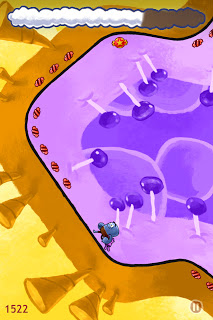 Last year, one of the more interesting platform puzzlers hit the AppStore; Deo, from the development studio Strapped to a Meteor. Since the release, they’ve been hard at work coming up with another unique and original game for the iOS, and it’s finally hit the AppStore. What is it this time? An endless runner called Mr. Dreamer. If you checked out our preview of the game about a week ago, then you already have a pretty good idea of what the game is. But if you haven’t, here’s the scoop.
Last year, one of the more interesting platform puzzlers hit the AppStore; Deo, from the development studio Strapped to a Meteor. Since the release, they’ve been hard at work coming up with another unique and original game for the iOS, and it’s finally hit the AppStore. What is it this time? An endless runner called Mr. Dreamer. If you checked out our preview of the game about a week ago, then you already have a pretty good idea of what the game is. But if you haven’t, here’s the scoop. Mr. Dreamer is a score-chasing, endless runner of sorts. On the main menu, you’re shown a strange little guy who’s stuck in an office cubicle with a stuffed animal by his side, pictures of his family on the walls, and the sounds of a keyboard clicking and phones ringing in the background. Looking bored and staring off into space, one you hit the ‘Play’ button, you’re off into a dream world, running up a two sided pathway in a dream world ripe with candy and sweets.
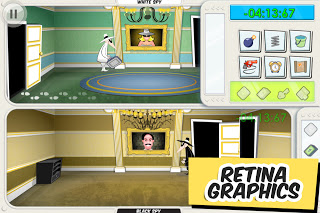 One thing that absolutely love about this version of Spy Vs. Spy is that it includes the original Atari version alongside the remake, and you can change to the retro version before starting any level simply by hitting ‘Retro’ on the level select screen! Now, Spy Vs. Spy is a blast to play, especially when you’ve got another player. I can still remember staying at a friends house when I was a kid, up all night playing this game. And you guessed it; this iOS version of Spy Vs. Spy includes both Local (through Bluetooth) as well as Online (through GameCenter) Multiplayer.
One thing that absolutely love about this version of Spy Vs. Spy is that it includes the original Atari version alongside the remake, and you can change to the retro version before starting any level simply by hitting ‘Retro’ on the level select screen! Now, Spy Vs. Spy is a blast to play, especially when you’ve got another player. I can still remember staying at a friends house when I was a kid, up all night playing this game. And you guessed it; this iOS version of Spy Vs. Spy includes both Local (through Bluetooth) as well as Online (through GameCenter) Multiplayer. 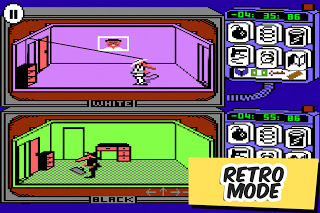 There’s a couple of ways you can play Spy Vs. Spy. As you make your way through each collection of rooms, you can either search for the briefcase, which lets you hold all of the items at once, or, you can search through all of the rooms, looking for each item one at a time, and then figure out where to hide it until you’ve found all 4 items, either way, you do need to find the briefcase before exiting the level, but this way, you’re able to trap wherever it is that you’re hiding your items, and you don’t run the risk of running into the other Spy with all of the items on you. Once you enter the room where the other Spy is, you drop all of the items that you’re holding and they go into the nearest hiding spot. Then you either need to get out of the room as quickly as possible, or fight, and beat up, the other Spy so that you can leave with all of the items that you‘ve both collected. There’s also a third option; you can sit in the room with the exit door, and wait for the other Spy to collect each of the 4 items, and then beat them up when they enter. Doing this is risky, and isn’t recommended unless you have no other choice. There’s also an added search going on along-side the search for the 4 items; looking for stars. Each level has a possible 3 star ranking, and however many stars you find in each level is what your ranking will be. All of the stars and items can be seen on your map, which is readily accessible in a slide-out menu with all of your traps.
There’s a couple of ways you can play Spy Vs. Spy. As you make your way through each collection of rooms, you can either search for the briefcase, which lets you hold all of the items at once, or, you can search through all of the rooms, looking for each item one at a time, and then figure out where to hide it until you’ve found all 4 items, either way, you do need to find the briefcase before exiting the level, but this way, you’re able to trap wherever it is that you’re hiding your items, and you don’t run the risk of running into the other Spy with all of the items on you. Once you enter the room where the other Spy is, you drop all of the items that you’re holding and they go into the nearest hiding spot. Then you either need to get out of the room as quickly as possible, or fight, and beat up, the other Spy so that you can leave with all of the items that you‘ve both collected. There’s also a third option; you can sit in the room with the exit door, and wait for the other Spy to collect each of the 4 items, and then beat them up when they enter. Doing this is risky, and isn’t recommended unless you have no other choice. There’s also an added search going on along-side the search for the 4 items; looking for stars. Each level has a possible 3 star ranking, and however many stars you find in each level is what your ranking will be. All of the stars and items can be seen on your map, which is readily accessible in a slide-out menu with all of your traps. 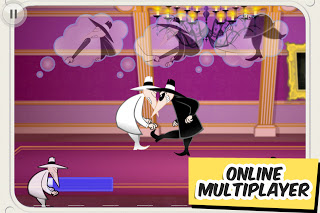
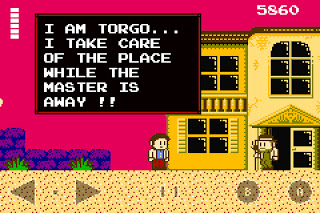 Mike and his family have gotten lost while on vacation, and they couldn’t have picked a worse spot to get lost in. Now Mike, armed with a gun, needs to get his wife, daughter, and dog, safely home before the monsters wind up getting the best of them. Like many platformers, the game doesn’t really rely on the story to drive the game, but it does help explain why you’re fighting massive rats and avoiding floating skulls. It also opens up a fairly wide variety of environments and situations which you’ll be able to run, jump, and shoot your way out of.
Mike and his family have gotten lost while on vacation, and they couldn’t have picked a worse spot to get lost in. Now Mike, armed with a gun, needs to get his wife, daughter, and dog, safely home before the monsters wind up getting the best of them. Like many platformers, the game doesn’t really rely on the story to drive the game, but it does help explain why you’re fighting massive rats and avoiding floating skulls. It also opens up a fairly wide variety of environments and situations which you’ll be able to run, jump, and shoot your way out of. 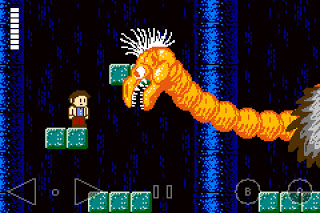 The level design is top notch, though there are some aspects of the design that I didn’t completely agree with in the beginning. For instance; There’s a lot of screen changing done with stairs. These stairs often go down. However, if you jump just a pixel beyond the stairs, you won’t land on the stairs on the screen beneath, you wind up dying. This is kind of frustrating, and hard to understand at first, but as you progress through the game, and see all of the areas that you can reach by not going down stairs, and by trying to jump, and maneuver around enemies and hazards in order to get there, you see why it was done that way. If you could just fall into a screen under where you were, there wouldn’t really be any consequences for missing a jump, or running into a rotating spike. Though since the game is also centered around speed-runs, falling down screen after screen could have been an even better deterrent from screwing up at those parts, it would also make it easy to fly through a couple screens. And now I completely understand why it is the way it is, and feel I should praise FreakZone for giving thought to every angle, and coming up with the best solution for things like this throughout the entire game.
The level design is top notch, though there are some aspects of the design that I didn’t completely agree with in the beginning. For instance; There’s a lot of screen changing done with stairs. These stairs often go down. However, if you jump just a pixel beyond the stairs, you won’t land on the stairs on the screen beneath, you wind up dying. This is kind of frustrating, and hard to understand at first, but as you progress through the game, and see all of the areas that you can reach by not going down stairs, and by trying to jump, and maneuver around enemies and hazards in order to get there, you see why it was done that way. If you could just fall into a screen under where you were, there wouldn’t really be any consequences for missing a jump, or running into a rotating spike. Though since the game is also centered around speed-runs, falling down screen after screen could have been an even better deterrent from screwing up at those parts, it would also make it easy to fly through a couple screens. And now I completely understand why it is the way it is, and feel I should praise FreakZone for giving thought to every angle, and coming up with the best solution for things like this throughout the entire game.